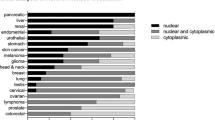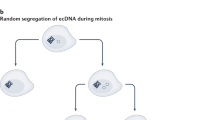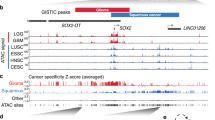Abstract
Aurora kinases are known to play a key role in maintaining mitotic fidelity, and overexpression of aurora kinases has been noted in various tumors. Overexpression of aurora kinase activity is thought to promote cancer development through a loss of centrosome or chromosome number integrity. Here we observed augmentation of G12V-mutated HRAS-induced neoplastic transformation in BALB/c 3T3 A31-1-1 cells transfected with Aurora-A. Aurora-A-short hairpin RNA (shRNA) experiments showed that the expression level of Aurora-A determines susceptibility to transformation. Aurora-A gene amplification was noted in human patients with tongue or gingival squamous carcinoma (4/11). Amplification was observed even in pathologically normal epithelial tissue taken at sites distant from the tumors in two patients with tongue cancer. However, overexpression of Aurora-A mRNA was observed only within the tumors of all patients examined (11/11). Our data indicate that Aurora-A gene amplification and overexpression play a role in human carcinogenesis, largely due to the effect of Aurora-A on oncogenic cell growth, rather than a loss of maintenance of centrosomal or chromosomal integrity.
This is a preview of subscription content, access via your institution
Access options
Subscribe to this journal
Receive 50 print issues and online access
$259.00 per year
only $5.18 per issue
Buy this article
- Purchase on Springer Link
- Instant access to full article PDF
Prices may be subject to local taxes which are calculated during checkout




Similar content being viewed by others
References
Bischoff JR, Anderson L, Zhu Y, Mossie K, Ng L, Souza B, Schryver B, Flanagan P, Clairvoyant F, Ginther C, Chan CS, Novotny M, Slamon DJ and Plowman GD . (1998). EMBO J., 17, 3052–3065.
Carmena M and Earnshaw WC . (2003). Nat. Rev. Mol. Cell. Biol., 4, 842–854.
Davies H, Bignell GR, Cox C, Stephens P, Edkins S, Clegg S, Teague J, Woffendin H, Garnett MJ, Bottomley W, Davis N, Dicks E, Ewing R, Floyd Y, Gray K, Hall S, Hawes R, Hughes J, Kosmidou V, Menzies A, Mould C, Parker A, Stevens C, Watt S, Hooper S, Wilson R, Jayatilake H, Gusterson BA, Cooper C, Shipley J, Hargrave D, Pritchard-Jones K, Maitland N, Chenevix-Trench G, Riggins GJ, Bigner DD, Palmieri G, Cossu A, Flanagan A, Nicholson A, Ho JW, Leung SY, Yuen ST, Weber BL, Seigler HF, Darrow TL, Paterson H, Marais R, Marshall CJ, Wooster R, Stratton MR and Futreal PA . (2002). Nature, 417, 949–954.
Ewart-Toland A, Briassouli P, de Koning JP, Mao JH, Yuan J, Chan F, MacCarthy-Morrogh L, Ponder BA, Nagase H, Burn J, Ball S, Almeida M, Linardopoulos S and Balmain A . (2003). Nat. Genet., 34, 403–412.
Gigoux V, L’Hoste S, Raynaud F, Camonis J and Garbay C . (2002). J. Biol. Chem., 277, 23742–23746.
Goepfert TM and Brinkley BR . (2000). Curr. Top. Dev. Biol., 49, 331–342.
Goyal RK, Lin P, Kanungo J, Payne AS, Muslin AJ and Longmore GD . (1999). Mol. Cell. Biol., 19, 4379–4389.
Harrington EA, Bebbington D, Moore J, Rasmussen RK, Ajose-Adeogun AO, Nakayama T, Graham JA, Demur C, Hercend T, Diu-Hercend A, Su M, Golec JM and Miller KM . (2004). Nat. Med., 10, 262–267.
Hirota T, Kunitoku N, Sasayama T, Marumoto T, Zhang D, Nitta M, Hatakeyama K and Saya H . (2003). Cell, 114, 585–598.
Kakunaga T, Yamasaki H and World Health Organization, International Agency for Research on Cancer, National Cancer Institute (US) and United States Environmental Protection Agency. (1985). Transformation assay of established cell lines: mechanisms and application proceedings of a workshop organized by IARC in collaboration with the US National Cancer Institute and the US Environmental Protection Agency, Lyon, 15–17 February 1984. International Agency for Research on Cancer; Distributed by Oxford University Press: Lyon; Oxfordshire, Oxford: New York.
Katayama H, Ota T, Jisaki F, Ueda Y, Tanaka T, Odashima S, Suzuki F, Terada Y and Tatsuka M . (1999). J. Natl. Cancer Inst., 91, 1160–1162.
Katayama H, Sasai K, Kawai H, Yuan ZM, Bondaruk J, Suzuki F, Fujii S, Arlinghaus RB, Czerniak BA and Sen S . (2004). Nat. Genet., 36, 55–62.
Meraldi P, Honda R and Nigg EA . (2002). EMBO J., 21, 483–492.
Minoshima Y, Kawashima T, Hirose K, Tonozuka Y, Kawajiri A, Bao YC, Deng X, Tatsuka M, Narumiya S, May Jr WS, Nosaka T, Semba K, Inoue T, Satoh T, Inagaki M and Kitamura T . (2003). Dev. Cell., 4, 549–560.
Parada LF, Tabin CJ, Shih C and Weinberg RA . (1982). Nature, 297, 474–478.
Sen S, Zhou H and White RA . (1997). Oncogene, 14, 2195–2200.
Tatsuka M, Mitsui H, Wada M, Nagata A, Nojima H and Okayama H . (1992). Nature, 359, 333–336.
Tatsuka M, Ota T, Maeda M, Wada M, Yamagishi N, Taniguchi S, Seiki M and Odashima S . (1997). Int. J. Cancer, 71, 88–93.
Tatsuka M, Ota T, Yamagishi N, Kashihara Y, Wada M, Matsuda N, Mitsui H, Seiki M and Odashima S . (1996). Mol. Carcinogen., 15, 300–308.
Terada Y, Tatsuka M, Suzuki F, Yasuda Y, Fujita S and Otsu M . (1998). EMBO J., 17, 667–676.
Tocque B, Delumeau I, Parker F, Maurier F, Multon MC and Schweighoffer F . (1997). Cell Signal., 9, 153–158.
Zhou H, Kuang J, Zhong L, Kuo WL, Gray JW, Sahin A, Brinkley BR and Sen S . (1998). Nat. Genet., 20, 189–193.
Acknowledgements
We thank Yasuhiko Terada for his valuable suggestions. We would also like to thank Fumio Suzuki for his administrative support. MT is supported by REIMEI Research Resources (Grants H12-040 and H15-030) from the Japan Atomic Energy Research Institute.
Author information
Authors and Affiliations
Corresponding author
Additional information
Supplementary Information accompanies the paper on Oncogene website (http://www.nature.com/onc)
Supplementary information
Rights and permissions
About this article
Cite this article
Tatsuka, M., Sato, S., Kitajima, S. et al. Overexpression of Aurora-A potentiates HRAS-mediated oncogenic transformation and is implicated in oral carcinogenesis. Oncogene 24, 1122–1127 (2005). https://doi.org/10.1038/sj.onc.1208293
Received:
Revised:
Accepted:
Published:
Issue Date:
DOI: https://doi.org/10.1038/sj.onc.1208293
Keywords
This article is cited by
-
Three-dimensional nuclear telomere architecture and differential expression of aurora kinase genes in chronic myeloid leukemia to measure cell transformation
BMC Cancer (2022)
-
Targeted therapies for non-HPV-related head and neck cancer: challenges and opportunities in the context of predictive, preventive, and personalized medicine
EPMA Journal (2019)
-
Aurora kinase targeting in lung cancer reduces KRAS-induced transformation
Molecular Cancer (2016)
-
Effect of AURKA Gene Expression Knockdown on Angiogenesis and Tumorigenesis of Human Ovarian Cancer Cell Lines
Targeted Oncology (2016)
-
Osteoprotegerin secreted by inflammatory and invasive breast cancer cells induces aneuploidy, cell proliferation and angiogenesis
BMC Cancer (2015)



